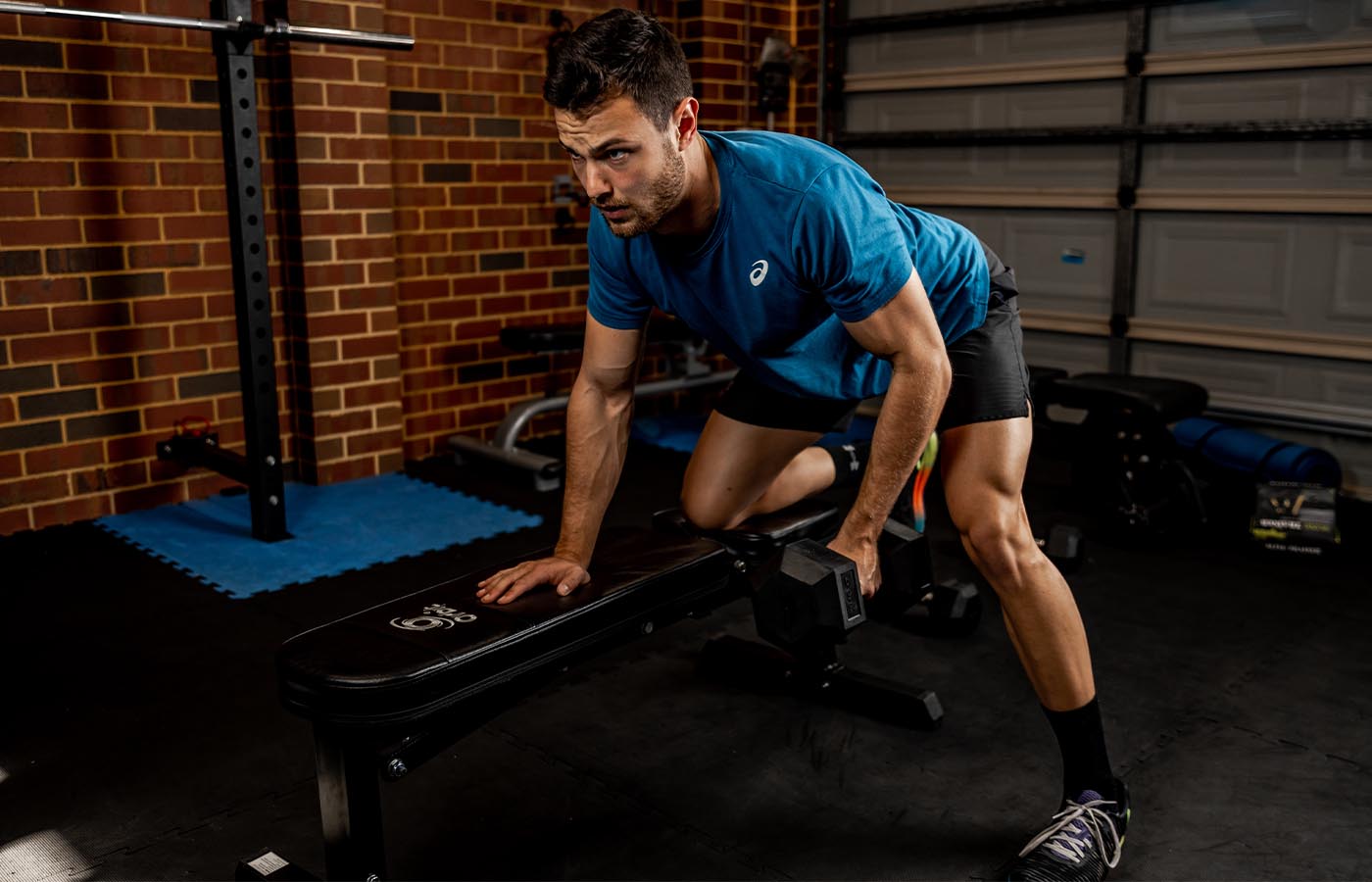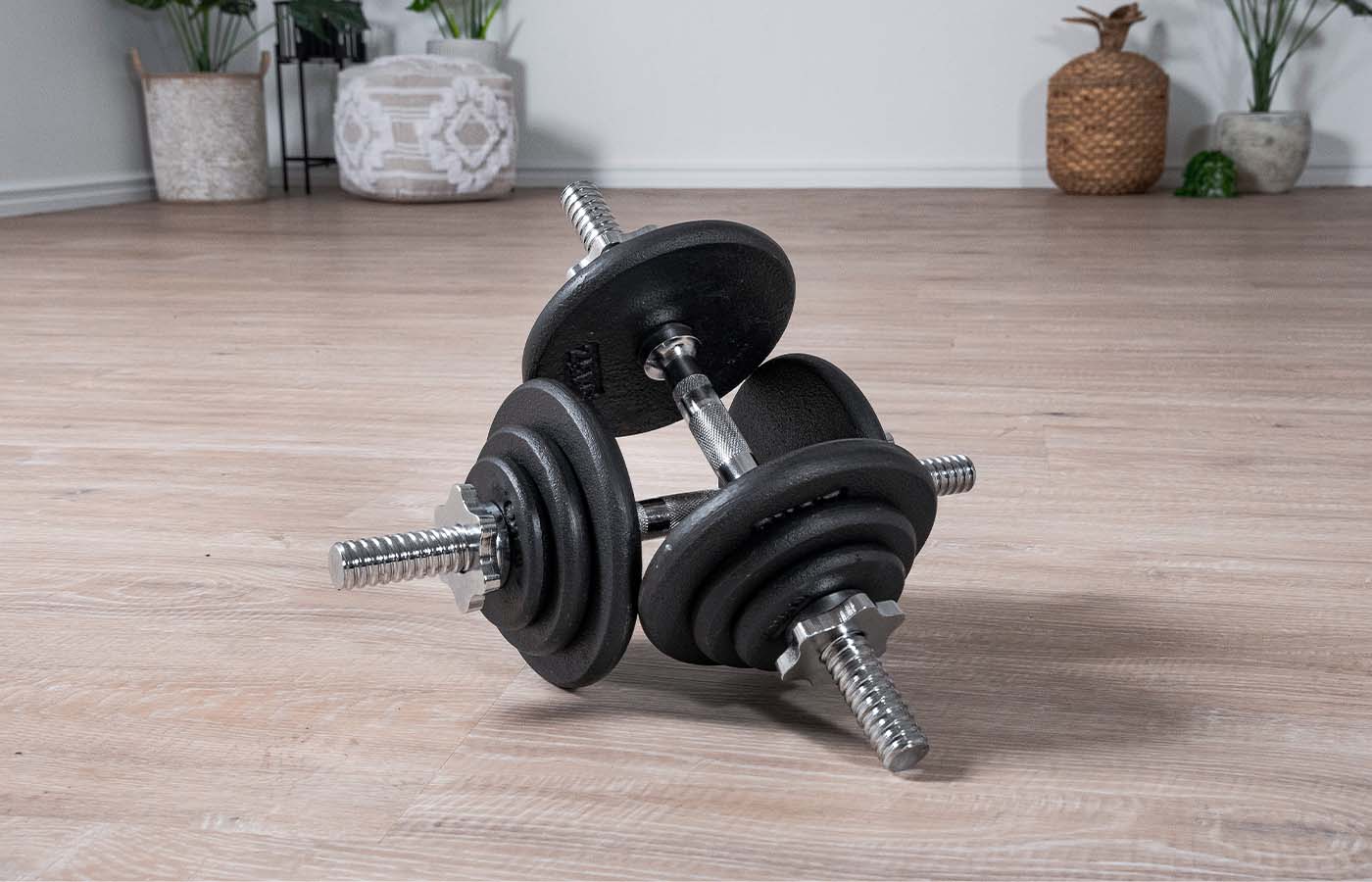Beginner's Guide: Strength Training With Free Weights

If you've never done strength training before, the idea of stepping into a gym can feel daunting. Sharing floor space with buff powerlifters as they throw around 50kg dumbbells, or worrying about how to operate complex exercise machines like a squat rack is intimidating.
That’s why many people begin their strength training journey by using free weights at home.
In this blog post, you’ll learn why free weights are an ideal introduction to strength training and the gear you need to get started.
The benefits of strength training in general

While muscle growth and strength are the primary reasons why people get into strength training, it actually does a lot more good for the body.
When done properly and regularly, strength training reduces the risk of injury by teaching you how to maintain your bones and muscles in proper alignment. It also prevents muscle loss and bone weakness due to ageing and lowers the risk of developing health complications caused by excessive visceral fat in the body.
Plus, contrary to the myth that strength training just “bulks you up”, this form of exercise can help with flexibility and mobility and build lean muscle mass.
Another myth is that strength training doesn’t burn many calories. While cardiovascular training does torch more calories while you work out, the lean muscle you build from strength training increases your basal metabolic rate — the rate at which your body expends energy when at rest. That means you continue to burn calories even after your workout.
Related: See Why You'll Love These 6 Benefits of Having Your Own Home Gym.
Why free weights are the best way to get started with strength training

You can reap all of the major benefits of strength training using free weights. Although not as impressive-looking as a home gym machine, free weights are very effective for beginner strength training workouts.
For one, free weights let you work out anywhere. If gym membership fees aren’t within your budget, buying free weights is an affordable option that will also allow you to exercise in the privacy of your own home.
Free weights also force you to stabilise yourself as you exercise. Maintaining balance and proper form while working out with this equipment requires you to activate more muscle groups and constantly engage your core, resulting in a more thorough workout session that will also improve your sense of balance.
And because free weights aren’t fixed within a limited range of motion, they let you do strength training exercises that are also functional. They will have you moving through all three planes of motion — forward, backward, and side to side — similar to how you perform most everyday activities.
We also know that weight training exercises for seniors are some of the best ways to fight sarcopenia (flesh loss due to ageing).
Why form (technique) is vital to your success
%20is%20vital%20to%20your%20success.jpg)
Having proper form (technique) is fundamental to avoid injury. Before you start those dumbbell curls, you want to learn the right technique.
One of the best online resources is https://exrx.net/WeightTraining because it shows you short video clips of the right exercises to target each muscle group.
When starting out, you might consider working with a personal trainer to guide, motivate and correct you. A good PT knows how to explain and demonstrate correct movement execution, which muscle groups you should activate, and the cues you need to remember to maintain good form.
You should always try to perform exercises in front of a mirror. This can feel a little awkward at first, but it is essential to help maintain your form.
Lastly, never sacrifice proper form for heavier weights. Sometimes our egos can get in the way. We add more weight plates but our form is all over the place. It’s a sure-fire way to get an injury and you’ll find you won’t make any strength gains.
Which free weights should I buy when just starting out?

Here’s a shopping list of free weights and accessories to get you started:
- 21kg dumbbell spin lock set - this contains the basics such as 0.5kg, 1.25kg, 2.5kg weights plates, dumbbell rods and spin locks
- 6’ weight bar and 2x spring clips to help you with more compound movements such as deadlifts and squats, and your weight plates will fit on it easily
- Adjustable weight bench - ideal for helping you perform dumbbell rows, chest presses, shoulder presses and other exercises
Dumbbells are always a good start. They lend themselves well to unilateral strength training so that you don’t compensate for your weak side with your stronger one. You can always build up your weight plates and accessories over time. For now, you want to focus on proper form.
Why progressive overload is your ticket to strength gains

At the beginning of your strength training journey, you may feel barely able to complete your reps. Once you hit your stride and start working out regularly, you’ll find your exercises easier to perform - this is called plateauing. Now it’s time to raise your weights, reps, and frequency of strength training.
Enter progressive overload.
Progressive overload training lets you continue to challenge your body and keep it from plateauing so you get fitter and stronger. However, experts suggest doing it gradually — about two weeks to a month since you first began doing a routine — to ensure that you have sufficient muscle memory to maintain proper form throughout the exercise. In fact, it would be best to work with a trainer on this so you can intensify your workouts safely and effectively.
Of course, better lifestyle practices will help maximise strength training’s benefits. Go for a diet rich in high-quality protein and nutrients to build lean muscles and have enough fuel to power through your training.
A quick word on the dangers of overtraining

Overtraining is very common amongst beginners. Along with poor form, training too much is one of the biggest causes of injury. Because we tend to start seeing results from strength training very quickly, we get excited. It’s easy to overcapitalise. We do more sessions per week, do more reps and more sets, add more weight and try more exercises.
You want to follow a schedule that allows you to have adequate rest between workouts.
Always avoid overextending yourself to the point of extreme soreness or injury. If you’re injured, you can’t train.
Lastly, get enough sleep. Exercising, especially strength training, creates a surge of adenosine that drives your need for sleep. So, listen to your body and get quality shut-eye regularly.
Our team of fitness experts will help set you up with the right free weights and accessories to get you on your way to building a better body. Call 1300 13 42 13 or email us today.











